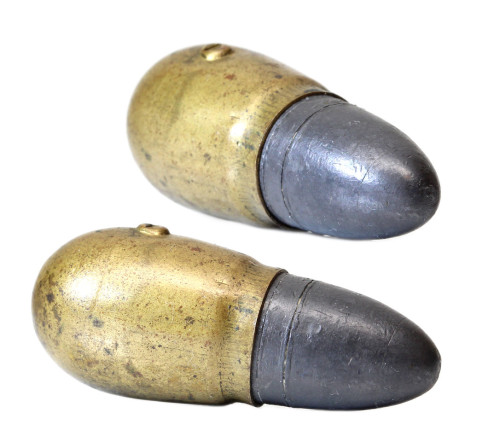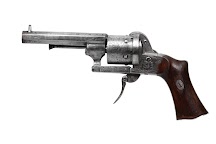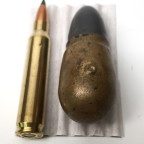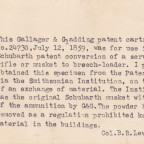Note: All new content is published at my new website, AaronNewcomer.com. This site will remain around until everything is transfered there.
Please visit AaronNewcomer.com to see lots of new articles on pinfire guns, Pauly guns, rare gun-related journals and books, unique cartridges and more!
Casimir Lefaucheux Patent 8955
September 18, 2018Here is the only copy of a patent by Casimir Lefaucheux that is known to exist in a private collection. This is French patent number 8955. It was filed on 26 July 1850 and approved on 23 October 1850. It describes a reusable pinfire shotshell that has a base that unscrews to allow easy reloading. It also pictures a tool to extract the shell from the gun and unscrew it.
During the time period that this patent was made they would typically hand write and draw two copies of a patent; one copy for the French patent office and one for the inventor or patent lawyer. The copy in the French patent office is slightly different since they were hand made. This difference is most noticeable by the different location of Casimir Lefaucheux’s signature.
It is thought than the majority of older documentation from Casimir Lefaucheux and his company was lost during the various German and US occupations of the Lefaucheux family castle. The Lefaucheux family archives have quite a few patents by Eugene Lefaucheux, Casimir’s son and the one who continued the business after Casimir’s death but they do not have any by Casimir.
This particular patent and some others (along with their rights) were bought by Jules Gévelot and stored with many other documents in the attic of one of the Société Française des Munitions factories for many years. When SFM closed down in 1992, one of the workers saved many of these documents and sold a bunch of them to a French collector who has done a lot of research on and has written articles and books on SFM. Then on 15 September 2013 I was able to acquire it and had a conservator preserve it in museum-grade framing so it will be around for years to come!
2 Comments »Eley Cartridge Board with Pinfires!
April 25, 2018I recently picked up an early Eley Cartridge Board with all 5 pinfire pistol cartridge sizes on it. Some of the other notable cartridge on it are the .44 Henry rimfire and the Spencer rimfires as well as the .577 Tranter cartridges.
This cartridge board dates to around 1886 based on the date the .45 Marlin first showed up in Eley catalogs and price lists.
It would’ve been in a frame with the company’s name printed in it too.
Here is a picture of the back which interestingly also has the printed image. I am not sure of the reasoning behind this and it is a mirror image of the front so the words do not match up with where the cartridges are in the front.
No Comments »The Pinfire Page
March 21, 2018
For the last 5 years I have had a permanent column in the International Ammunition Association Journal. This column showcases my research, images and other documents related to the pinfire system.
I recently compiled these together an put them in a single publication which is now on Amazon. So feel free to check it out!
It’s $29.99 and can be purchased on Amazon by clicking here!
No Comments »Casimir Lefaucheux’s first pistol and the very first cartridge pistol!
March 14, 2018I have finally added the last specimen needed to now have an example of all three pistol designs by Casimir Lefaucheux.
On 16 Jun 1832 Casimir Lefaucheux filed for patent no 1832 in France for protection of his breechloading design that allowed for the barrel to drop down on a hinge. It was approved on 28 Jan 1833 and is basically the same format all double barrel shotguns still use to this day. It is probably one of the most important designs in the history of firearms development.
Later that year on 29 Dec 1832 he filed for an addendum to the patent that added some protections for some modifications. That addendum was approved on 13 Mar 1833 and describes the specification that this gun pictured follows. One of the main improvement in this the addendum was the “opening key” which was the lever under the barrel that allowed the breach to open.
At the time, he licensed this design to a few of the best gun manufactures (arquebusiers) in France who all made shotguns following this breechloading design. As an advertising measure he even printed their names on the pinfire shotshell that that he contracted with Jules Gévelot to make for them.
The forth addition to this same patent finally adds protection to the design of the pinfire cartridge; though based on the contract dates they were being made before it was filed on 08 Jan 1835 and approved on 31 Mar 1835.
This pinfire cartridge was the first fully self contained cartridge. Everything before this relied on multiple pieces, such as an external percussion cap being placed somewhere. This combined it all together.
For another 5 years or so there would be no pinfire pistol cartridges made or patented. This early pistol actually used shotshells that were cut down as shown in the picture above.
It is chambered for a 24g ball and a couple variations of these cut down shotshells are known to exist. They are incredibly rare. And that is the only known example of that full shotshell pictured.
So based on this info of this being the first cartridge and this pistol being the first gun made for it I give you the very first cartridge pistol!
Also, for a little more info, here is the example of this same design (but a double barrel version) from the Lefaucheux Family Archives.
No Comments »Bracelet made for carrying pinfire cartridges
Here is a neat little pinfire carrying bracelet I picked up recently. It is all leather with a brass clasp and securely holds 13 cartridges!
1 Comment »Norwegian M/64/98 Lefaucheux Pinfire Revolver with Military Cartridge Box
February 12, 2018This is an example of one of the scarce pinfire boxes made by Société Française des Munitions for the Norwegian military as well as one of the Norwegian military Lefaucheux pinfire revolvers.
In 1859 the Norwegian Navy ordered a handful of Lefaucheux Model 1854s for testing and then in 1864 purchased 1500 Lefaucheux model 1854 revolvers which were split amongst the Norwegian Army and Navy. Norway designated these revolvers as the Model M/1864.


In 1898 some of these revolvers which were still in service were modified to add the piece of metal on top to stiffen the frame. These modified revolvers were designated as the M/64/98 and is what is pictured here. Norway designated the revolver as 11mm which is why SFM marked the box as 11mm. The exact same cartridges were sold elsewhere as 12mm. The box contains 18 cartridges which was enough to reload the revolver 3 times.

Norway also manufactured additional ball and blank load pinfire cartridges at their state-owned cartridge factories. An early Norwegian manual about how to manufacture pinfire cartridges indicates that they followed the French technical specifications for these.
5 Comments »9mm Javelle Patent Pinfire Revolver Manufactured by Verney-Carron
May 6, 2017This is a 9mm Javelle patent pinfire revolver manufactured by Verney-Carron of St. Etienne, France somewhere around the late 1850s to early 1860s.
He designed this gun to allow easy removal of the cylinder. His intentions were that people could carry extra cylinders that were already loaded and quickly reload the revolver.
Here is a scan of my copy of British Patent no. 1362 from 1861 which goes into details on the design for a later variation of Javelle’s revolver but is still very similar to the mechanism used in this example. This is specifically for his later revolver which shot his horizontal pinfire cartridges which were an early form of centerfire cartridges.
2 Comments »The Very First Cartridge Revolver
August 10, 2016This is the earliest version of the pinfire pepperbox revolver manufactured by Casimir Lefaucheux around 1845-1846.
Lefaucheux “borrowed” the action from Guillaume Mariette of Liège, Belgium who made a percussion pepperbox a few years prior.
Casimir’s patent modified it to make it breech-loading by adding in that middle piece and allowing the barrels to come off. He said he also added many safety features.
Mariette and Lefaucheux argued in court a few times over this but Lefaucheux ended up changing his handle and frame style and action a little bit to both appease Mariette and add newer improvements.
It is chambered for a 50 bore (based on the old French livre, making it an 11.81mm caliber) cartridge that Jules Joseph Chaudun held a patent for. This is effectively a 12mm pinfire cartridge, and most later 12mm pinfire cartridges fit it in.
Chaudun seemingly hand-made these cartridges as they all seem to be slightly different. They exist in a round-ball load, the candle-flame bullet load as shown and a shot load.
One interesting thing to note is that if you notice the little lever above the trigger, behind the hammer; when you pull it down with your other thumb (which is not extremely easy) and pull the trigger it only rotates the barrel and does not move the hammer at all.
No Comments »Lefaucheux 7mm Double Action Pinfire
August 16, 2015 This is a double-action-only 7mm pinfire revolver made by Eugene Lefaucheux in Paris, France. It follows his patent from 07 June 1858.
This is a double-action-only 7mm pinfire revolver made by Eugene Lefaucheux in Paris, France. It follows his patent from 07 June 1858.
On the barrel is inscribed:
DUMOULIN ARQer À ROUEN
Dumoulin was a gun maker (arquebusier; ARQer) and gun retailer in Rouen, Seine-Maritime, Upper Normandy, France. He must have procured a custom order from Lefaucheux of these guns to sell at his establishment.
All of the parts have part number “15 J” punched into them.
Based on the serial number and the frame design this would have been manufactured around August/September of 1861.
1 Comment ».58 Schubarth
July 10, 2015I have finally acquired a .58 Schubarth! It is one of the more desirable American cartridges and seems to trade for insane prices. There are only around a dozen known to exist. It was patented and made in 1861 by Casper D. Schubarth who resided at 6 North Main street Providence, RI.
This particular example was once owned by Colonel Berkeley R. Lewis of the United States Army Ordnance Corps. He acquired it from the Smithsonian Institution.
The whole idea of the cartridge and rifle is based on a modification and improvement of Gallager & Gladding’s cartridge and rifle that was created a couple years prior. I have new pictures of the Gallager & Gladding cartridge that I will feature in my Journal column (which is currently detailing the relationship of pinfire cartridges and the United States) sometime in the next few months. Schubarth’s improvement was essentially to make it waterproof.
It is an inside-primed pinfire. I believe his intentions were to make it easily reloadable with Minié balls and was offered to the government which did not decided to purchase it.
 The dimensions of it are as follows:
The dimensions of it are as follows:
Bullet Diameter: 0.61 inches
Bullet Weight: 551 grains
Powder Charge: 70 grains
Total Weight: 764 grains
Case Length: 1.13 inches
Total Length: 2 inches
While I do not have ballistic info on it, in 1861 Mr. Schubarth said that “It will be seen that the powder is fired in the middle of the charge thus causing a rapid combustion [and] that this causes so great force be generated that 60 grains of powder has driven bullet through 15 one inch boards at a distance one hundred yards ”
Also, here is the patent, and an image of it beside a .223 for scale.
2 Comments »Page: 1 2 3 4














































